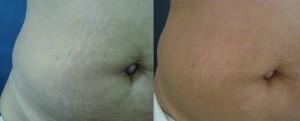Scars, especially when mature, are generally considered hard to treat, as existing treatment modalities do not bring significant improvement. One such modality — transepidermal delivery — is promising but has so far been unsuccessful.
In a new treatment called iTED (IMPACT Transepidermal Delivery), difficult-to-treat conditions such as scars and stretch marks can be effectively treated by combining the regenerative effect of fractional ablation with the healing effect of topical products such as tretinoin and glycolic acid, which are delivered beyond the epidermal–dermal junction via microchannels and Alma Lasers IMPACT acoustic ultrasound module.
Microplasma fractional ablation
Fractional ablation overcomes the stratum corneum by creating controlled microchannels, which pass the epidermal-dermal junction. While multiple fractional ablative lasers exist, such as the Erbium and CO2, these technologies carry an inherent risk of post-inflammatory hyperpigmentation (PIH), especially in darker-skinned patients.
Alma Lasers developed a fractional ablative technology that significantly reduces the risk of PIH. Based on UniPolar RF, the fractional ablative applicator is a roller with pyramid shaped cogs. The UniPolar RF flows through the roller, and as the pins approach the skin, a microplasma spark is formed between the cogs and the skin. The microplasma sparks produce microchannels 100–150 mm in depth (evaporation and thermal) and 80–120 mm in diameter on the skin surface.
It should be noted that the cogs do not penetrate the skin like other RF ablative technologies, but rather the ablation is fully formed by the microplasma spark. This microplasma ablation is independent of the patient’s skin type and is a chromophore-free event.
A recent randomised split face clinical study was performed by Professor Wei Lu and colleagues at the Shanghai Ninth People’s Hospital, China1. In the study of 33 Asian patients who received three sessions of either Alma Lasers’ fractional ablative microplasma or fractional ablative CO2, the results showed that both modalities have a similar therapeutic effect. However, 36.4% of patients treated with the CO2 experienced PIH, while no patients treated with microplasma experienced PIH.
Acoustic pressure ultrasound module
In histologies performed by Professor Arie Orenstien, Sheba Medical Center, Israel, and Dr Michael Gold, Nashville TN2, comparing the penetration of drugs to the skin following fractional ablation with and without the IMPACT acoustic ultrasound, it was proven that topically applied compounds do not penetrate the skin following fractional ablation alone. IMPACT uses a push–pull vibration cycle to act similar to mechanical pressure. The end result is a hammer-like effect that progressively advances the drugs beyond the epidermis–dermis junction.
Clinical study
The author recently completed a study of 16 patients clinically diagnosed with alba striae distensae3. Half had a history of striae from 2–17 years (Group 1), while the other half had a history of striae from 3–20 years (Group 2).
Group 1 was treated with iTED — microplasma, retinoic acid and the IMPACT ultrasound — while Group 2 was only treated with microplasma. All patients were assessed before, 30 days post-treatment, and 18 months post-treatment, with a subjective measurement made by three different non-treating physicians on a 5-point scale. Furthermore, within the clinical study, patients were asked to rank side effects including erythema, oedema, scarring and pain.
Results
Of the patients in Group 1 who were treated with the microplasma, retinoic acid and IMPACT ultrasound:
- Three improved from ‘severe’ to ‘moderate’
- Two improved from ‘severe’ to ‘mild’
- Two improved from ‘moderate’ to ‘mild’
- One improved from ‘marked’ to ‘mild’.
All patients in Group 1 showed high satisfaction with a low incidence of side-effects.
Within Group 2, which did not include the retinoic acid and IMPACT ultrasound:
-
Two patients improved from ‘severe’ to ‘marked’
-
One improved from ‘marked’ to ‘moderate’
-
One improved from ‘marked’ to ‘mild’
-
Four showed no improvement.
All patients in Group 2 showed low satisfaction with a low incidence of side-effects.
Conclusions
Fractional ablative microplasma technology, retinoic acid and IMPACT ultrasound are combined into a single treatment called iTED, which has proven to enhance the appearance of striae with very low side-effects and high patient satisfaction. Microplasma is a fractional ablative modality that reduces the risk of PIH, giving an advantage over other fractional ablative technologies. iTED may be used to treat a wide range of skin conditions aside from scars and striae, including hyperhidrosis of the palms, alopecia, skin whitening and other difficult-to-treat conditions.







